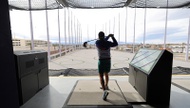For more than a century, the Young Electric Sign Company (YESCO) has helped shape Las Vegas’ iconic, neon image. Founded in Ogden, Utah, by English immigrant Thomas Young, YESCO has supplied the Strip and other marqueed corridors with glowing signs since the 1920s.
Having been a presence here for so long, the company has become a part of Las Vegas’ cultural and visual evolution. And now, Lighting Up Las Vegas: YESCO Marks a Glittering Century, an exhibition presented by the Las Vegas Convention and Visitors Authority (LVCVA) and the Neon Museum, uses archival photos and artifacts to take viewers through that history.
“Las Vegas has really been long associated with neon signs. It’s really been a defining element of Las Vegas and the city’s popular image,” says exhibit co-curator Derek Weis. “And YESCO has been one of the major players that’s really shaped that over the decades—not just neon, but [also] up to the present day with all the modern LED screens and stuff like that on the strip.”
Clark County Museum itself is marked by a digital sign off Boulder Highway that was donated and installed by YESCO in 2002. Exhibit-goers will be looking for that sign, probably not knowing that it, too, is part of the company’s local legacy.
YESCO sold its first signs in Nevada during the 1920s, and, according to the company’s website, ushered in a “Golden Age of Neon” with the installation of the Boulder Club sign in the 1940s, setting off the neon-ification of Fremont Street. Signs for Pioneer Club, Golden Nugget, Las Vegas Club and Eldorado Club followed shortly, giving the then-seedy stretch of Fremont its local nickname, “Glitter Gulch.”
“A lot of the things they created have stood the test of time,” Weis says. YESCO created and installed the 75-foot, 12,000-pound Vegas Vic in the ’50s, and it can still be seen today, nestled between the Golden Nugget and the Golden Gate under Fremont Street Experience’s light canopy. The wraparound sign for Binion’s Gambling Hall, installed in the ’60s, still remains at the entrance.
For the joint exhibit, Clark County Museum unearthed a collection of artifacts it had acquired from YESCO more than 30 years ago. Photos and sign letters from that collection are a part of the exhibit display, according to co-curator and LVCVA Archivist Kelli Luchs.
Originally intended to open in March 2020 for YESCO’s centennial anniversary, the exhibit was postponed due to the COVID-19 pandemic and has been on hold for more than two years. Luchs says she looks forward to highlighting YESCO’s historic signage using photos from the LVCVA’s Las Vegas News Bureau Archive, a collection more than seven decades old.
Luchs and co-curator Weis say the partnership with the Neon Museum helped to create a unique, in-depth exhibit. “They had the signs. We had the photos. So the partnership was really perfect to be able to work together to showcase the history of neon in Las Vegas,” Luchs says.
The Clark County Museum Guild will provide light refreshments at the opening reception on May 6. Guided tours will be provided by Luchs, Weis and museum staff.
Lighting Up Las Vegas: YESCO Marks a Glittering Century May 6-August 29; daily, 9 a.m.-4:30 p.m.; $1-$2. Opening reception May 6, 5 p.m., free. Clark County Museum, 702-455-7955.
Click HERE to subscribe for free to the Weekly Fix, the digital edition of Las Vegas Weekly! Stay up to date with the latest on Las Vegas concerts, shows, restaurants, bars and more, sent directly to your inbox!








